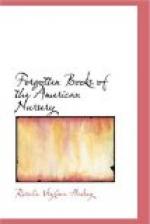Mrs. Gilman was born in Boston, and at sixteen years of age had published a poem most favorably criticised at the time. Marrying a clergyman who settled in Charleston, she continued her literary work, but was best known to our grandmothers as the author of “Recollections of a New England Housekeeper.” The “Rose Bud” soon blossomed into the “Southern Rose,” a family paper, but faded away in 1839.
Among other juvenile weeklies of the time may be mentioned the “Juvenile Rambler” and the “Hive,” which are chiefly interesting by reason of the opportunity their columns offered to youthful contributors.
Another series of “miscellaneous repositories” for the instructive enjoyment of little people was furnished by the Annuals of the period. These, of course, were modelled after the adult Annuals revolving in social circles and adorning the marble-topped tables of drawing-rooms in both England and America.
Issued at the Christmas and New Year seasons, these children’s Annuals formed the conventional gift-book for many years, and publishers spared no effort to make them attractive. Indeed, their red morocco, silk, or embossed scarlet cloth bindings form a cheerful contrast to the dreary array of black and drab cloth covering the fiction of both old and young. Better illustrations were also introduced than the ugly cuts “adorning” the other books for juvenile readers. Oliver Pelton, Joseph Andrews (who ranked well as an engraver), Elisha Gallaudet, Joseph G. Kellogg, Joseph I. Pease, and Thomas Illman were among the workers in line-engraving whose early work served to illustrate, often delightfully, these popular collections of children’s stories.
Among the “Annualettes,” “Keepsakes,” “Evening Hours,” and “Infant’s Hours” published at intervals after eighteen hundred and twenty-five the “Token” stands preeminent. Edited by Samuel G. Goodrich (Peter Parley) between the years eighteen hundred and twenty-eight and eighteen hundred and forty-two, its contents and illustrations were almost entirely American. Edward Everett, Bishop Doane, A.H. Everett, John Quincy Adams, Longfellow, Hawthorne, Miss Sedgwick, Eliza Leslie, Dr. Holmes, Horace Greeley, James T. Fields, and Gulian Verplanck—all were called upon to make the “Token” an annual treat to children. Of the many stories written for it, only Hawthorne’s “Twice Told Tales” survive; but the long list of contributors of mark in American literature cannot be surpassed to-day by any child’s book by contemporary authors. The contents, although written in the style of eighty years ago, are undoubtedly good from a literary standpoint, however out of date their story-telling qualities may be. And, moreover, the “Token” assuredly gave pleasure to the public for which its yearly publication was made.
[Illustration: Children of the Cottage]




